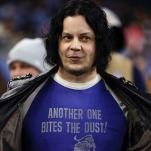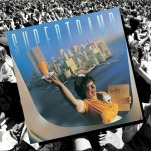The Comics Panel: July 19, 2007
Comics emerged from their "wow, they aren't just for kids any more" cocoon a while ago, but serious critical voices devoted to the form, as opposed to those simply acknowledging it, have been slow to emerge. But music and comics writer Douglas Wolk has delivered what will surely be a cornerstone of comics criticism for years to come: Reading Comics (Da Capo). It opens with a breezy, readable, but rigorous explanation of where comics come from and how they work, and closes with 18 case studies of applied criticism. While acknowledging the difference between art comics and mainstream comics, Wolk doesn't favor one over the other, offering a great explanation of why superhero comics continue to be pleasurable in one chapter, analyzing the formally playful qualities of Hope Larson's Gray Horses in another. Wolk is respectfully skeptical of some luminaries—including Will Eisner and Chris Ware—and perhaps not skeptical enough of visionaries who tend to go off the rails, but his book is thoughtful and entertaining throughout… A-
Stephen Colbert's science-fiction alter ego gets the comic-book treatment in the just-launched five-issue miniseries Stephen Colbert's Tek Jansen (Oni). The first issue, co-written by John Layman and Tom Peyer with art by Scott Chantler, finds Jansen running afoul of some apparently altruistic aliens who offer tremendous advances in return for a one micro-percentage tax. It's all a bit one-jokey, but it does have a naked Colbert and a monkey robot going for it. Jim Massey and Robbi Rodriguez—who just released the first collection of their Maintenance series—provide a funnier back-up story in which Jan goes undercover to forward an alien civil-rights cause… B-
The first edition of Andy Hartzell's Fox Bunny Funny was a handmade comic, consisting of a screened slipcover hugging a series of three bound booklets—sophisticated, lovely, but unwieldy. The new Top Shelf paperback edition puts the same content into a more standard book with well-deserved wider distribution. Hartzell's powerful, starkly rendered black-and-white story takes place in a cartoony, anthropomorphic world divided into foxes and the rabbits they prey on; images of dead rabbits are iconic and ubiquitous in fox society, and the dividing line between the animal worlds is harshly policed. So what happens when one fox secretly longs to be a bunny? A lot of quick action and intense emotional shocks. It's most tempting to read Fox Bunny Funny as a gay coming-of-age story, particularly given the specific ways Hartzell's fox protagonist expresses his individuality, and the ways his society punishes him for it, reinforcing accepted mores via a male peer group that pressures him toward socially encouraged violence. But it can just as easily serve as a broad metaphor for any square peg who's experienced the pain of being hammered into a round hole… A
The nearly 400 pages and seven years' worth of mini-comics collected in the John Porcellino anthology King-Cat Classix: The Best Of King-Cat Comics And Stories (D&Q) may seem immediately inconsequential, hardly worth being preserved in a handsomely designed hardcover edition with extensive endnotes. But the best way to treat this book is like a collection of poems, to be dipped into lightly, a few pieces at a time. Beneath the crude linework and dream-journalism, Porcellino has crafted an affecting scrapbook of a part-time artist's life. The decade-plus remove from these comics' initial publication only adds another layer of poignancy, since so many of its concerns are those of a young man, unaccountably adrift in a decade geared towards his generation… A-
Writer/artist Darwyn Cooke, best known for The New Frontier, has spent the better part of this decade winning a fervent following with his sharp storytelling and Silver-Age-by-way-of-Saturday-morning art. His revival of Will Eisner's The Spirit continues to be a monthly wonder, but he first came to comics via another crimefighter. Batman: Ego And Other Tails (DC) (yes, that spelling is correct) collects his Batman work, beginning with his debut, Ego, in which Bruce Wayne battles his own alter ego. The art still pops, even where the psychology is way too on-the-nose. By the time he'd moved on to the gripping, tragic Catwoman heist tale Selina's Big Score (also included, alongside some Batman short stories) Cooke had found his own voice, one that let his characters carry a weight that his uncluttered art doesn't immediately suggest… A-
Writer J. Michael Straczynski plays an Ego-like mind game in his first issue reviving Thor (Marvel), which finds the long-absent thunder god returning to life with some coaxing by his even-longer-absent alter ego Donald Blake. Straczynski has a history of launching titles with strong concepts, then losing them in the follow-through. In spite of some nice work from French artist Olivier Coipel, his Thor gets off to a shrug of a start, so maybe he'll reverse the habit. Relocating Thor to Oklahoma is at least a new idea… C+
The previous three volumes of the Flight anthology have all been focused pretty specifically on, well, flight, but Flight Volume Four (Villard) leaves that conceit behind and gets significantly more random and expansive, without losing any of its predecessors' heartbreakingly beautiful qualities. A large stable of animators, graphic designers, and web-comickers each contribute short stories, though this time around, those stories tend more toward complete narratives rather than arty vignettes. Among the standouts: Scott Cambell's weird story about Igloohead and Treehead, two lumpish little creatures that live up to their names, in a world where everyone's defined by the everyday objects residing on their heads; Michel Gagné's continuing wordless tales of a little unicorn-fox creature bounding around in a vast, overwhelming fantasy world; and Sarah Mensinga's "The Forever Box," about a box that stops time for the person inside. But there really isn't a clinker in the whole batch. The content is even kid-friendly, though the melancholy tone and graphic sophistication is aimed more at adults. These pieces are uniformly smart, beautiful, and vividly creative—comics just don't get much better… A
It's hard to believe that DC took so long to dedicate a couple of "Showcase Presents" volumes to two characters who defined the Silver Age: The Atom and The Flash. But rather than grumble that the flippin' Haunted Tank got its own book before DC trotted out Showcase Presents: The Flash and Showcase Presents: The Atom, better to enjoy the collections in question, both of which spotlight the clever adventure storytelling of writers John Broome and Gardner Fox, as well as the still-thrilling art of Carmine Infantino and Gil Kane. The Flash has the edge when it comes to readability, if only because the super-speedster's rogues' gallery remains one of the weirdest and most versatile in all of superhero-dom. (Also, running very fast is way cooler than shrinking very small.) But artwise, Infantino hadn't yet hit the peak he'd reach later with The Elongated Man, while Kane was showing a skill at illustrating action that remains arguably unparalleled. The Flash: A-… The Atom: B+
Superman used to be so popular that even his sidekicks had their own books. The stories published in Superman's Pal, Jimmy Olsen generally had two plots: When Jimmy wasn't going undercover to get a scoop, he was turning into some kind of weird creature. A '50s and '60s Superman staff dominated by writers Otto Binder and Jerry Siegel and artist Curt Swan let their imaginations run wild with these stories, many of them collected in the collection The Amazing Transformations Of Jimmy Olsen (DC). None of them reveal why, after being turned into a giant turtle, a genie, an alien, and a wolfman, Olsen wouldn't wise up and be a little more careful… A-





![Rob Reiner's son booked for murder amid homicide investigation [Updated]](https://img.pastemagazine.com/wp-content/avuploads/2025/12/15131025/MixCollage-15-Dec-2025-01-10-PM-9121.jpg)

























![HBO teases new Euphoria, Larry David, and much more in 2026 sizzle reel [Updated]](https://img.pastemagazine.com/wp-content/avuploads/2025/12/12100344/MixCollage-12-Dec-2025-09-56-AM-9137.jpg)








